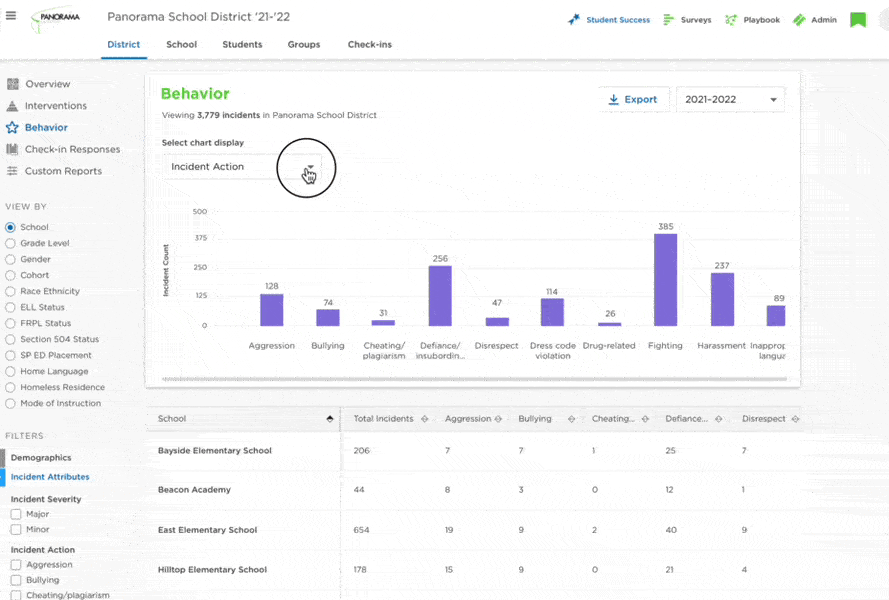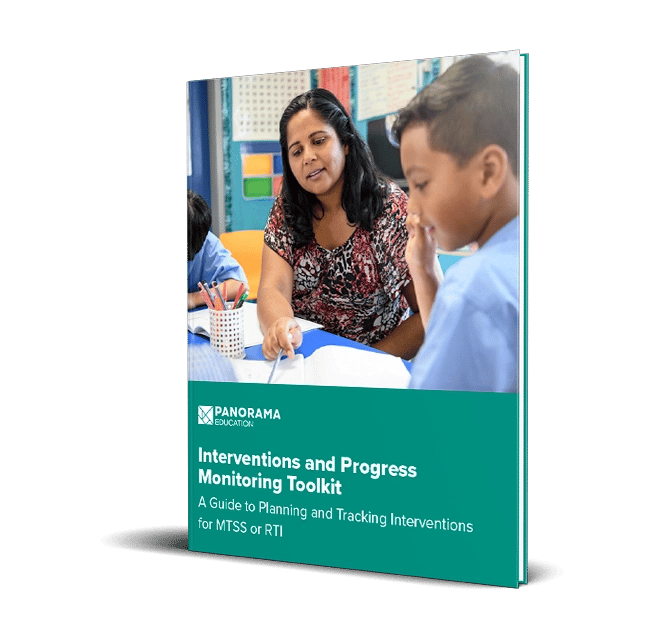As schools across the country face a surge of behavioral challenges in the wake of the pandemic, educators are increasingly focused on addressing behavior issues with targeted interventions. One of the most powerful tools for behavior management is the implementation of a well-designed behavior intervention plan (BIP).
Table of Contents:
What Is a Behavior Intervention Plan (BIP)?
The Role of Data in a BIP
How to Create a Behavior Intervention Plan
What Is Check-In/Check-Out (CICO)?
Common Challenges in BIP Implementation
Next Steps for District Leaders
What Is a Behavior Intervention Plan (BIP)?
A behavior intervention plan, also known as a behavior support plan, is an action plan for helping a student improve certain behaviors or reach a specific behavior goal. A behavior intervention plan typically consists of a goal, intervention strategy, timeline, and progress monitoring method.
A BIP can be implemented as part of a PBIS (Positive Behavioral Interventions and Supports) model or MTSS (multi-tiered system of supports) framework. It provides a measurable way to record:
- The student’s current behavior (the “before”)
- The intervention strategy or treatment plan
- Daily or weekly student progress
- Fidelity of implementation
- Final results at the end of the intervention
A good BIP is time-bound, so the plan should have a target end date. The interventionist should be able to make a decision about next steps at the end of the BIP, whether that’s to close out the intervention or rethink the strategies in place.
Ultimately, the purpose of a behavior intervention plan is to prevent unwanted behaviors and/or increase desired behaviors with a short-term targeted intervention.
The Role of Data in a BIP
The success of your behavior support plans depends on the quality of the data collected throughout the intervention process—and even before it begins.
Data can signal to educators that a student is in need of targeted support. A student may need a BIP if they exhibit persistent, disruptive behaviors that interfere with their learning or their peers’ learning. Common indicators include frequent office referrals, consistent non-compliance, aggressive behavior, or significant social challenges.
Data also helps in setting measurable and attainable goals for the BIP so the intervention plan is practical and achievable. Continuous data collection is integral for progress monitoring, an ongoing assessment of whether the intervention is working. Plus, if data shows that the intervention is not effective, adjustments can be made in real time.
.png?width=772&height=506&name=student%20overview%20life%20skills%20(2).png)
Use Student Success to get a “panoramic” view of student data across academics, attendance, and behavior
How to Create a Behavior Intervention Plan
Once you’ve determined that your student is in need of targeted support, it’s time to create a behavior intervention plan. This plan will be your blueprint for helping the student build specific skills or reach a goal. Download the behavior support plan template below with step-by-step instructions for writing an intervention plan.
1. Identify the Problem Behavior
Conduct a functional behavior assessment (FBA) to gather data on the student’s behavior. An FBA will help educators understand the causes and triggers behind a behavior to better address it.
An FBA involves gathering information in three ways:
- Observation: Direct observation of the behavior in different settings (e.g., classroom, playground, bus). Observers record when and where the behavior occurs, who is involved, and what happens before and after the behavior.
- Interviews: Information is gathered from the student and adults who interact with them regularly, such as teachers, parents, and coaches.
- Review of Records: Review past records, such as disciplinary actions, academic performance, or medical history if relevant.
2. Define the Behavior
While you and fellow educators may agree on what type of unwanted behavior is occurring, it’s helpful to get it in writing. Create a very clear definition that can be used to measure progress against throughout the intervention. Refer to the Big 5 (What, Where, When, Who, How Often) as you add more details.
For example, if the behavior in question involves inappropriate verbal outbursts during classroom, the specific and detailed definition may be:
"The student engages in inappropriate verbal outbursts, which are defined as shouting, yelling, swearing, or using offensive language during instructional time. This behavior occurs when the student is asked to complete a task, answer a question, or when a peer is interacting with the teacher. Each instance of the behavior typically lasts less than 30 seconds but disrupts the flow of the lesson and distracts other students."
3. Develop Hypotheses About the Behavior
Reflect on your data to develop a hypothesis about potential triggers and functions of the behavior. Take note of the antecedents, or the events that occur directly before the behavior and may be causing it. Is the student being asked to complete a task they find challenging, or being separated from a friend?
Record the consequences, or what happens immediately after the behavior. These consequences may actually be reinforcing the behavior by giving the student what they want. For example, the student may receive attention from peers after disrupting the class. Or if they throw away a worksheet, they may get sent out of the classroom where they don’t have to complete the assignment.
Use this information to develop a hypothesis to inform the BIP. Your hypothesis may be something like, “The student interrupts class to seek attention from peers and to avoid doing work they feel is too difficult.”
4. Select Interventions
Select research- and evidence-based interventions to address the behavior. Use tools like Panorama Playbook—a library of hundreds of intervention strategies—to find an approach for your student’s needs.

Don’t forget to address both the antecedents and consequences in your intervention plan, not just the behaviors themselves. Try to drill down to address the root cause of the behavior. This approach may involve modifying the environment to determine its effect on the behavior.
5. Develop the Plan
Fill out a detailed behavior intervention plan. Add as many details as you can, and be sure to loop in all the relevant roles and stakeholders. Include information about:
- Student name
- Intervention tier
- Goal
- Intervention strategies
- Champion
- Start date
- Duration
- Progress monitoring frequency and method
- Assessment baseline and target, if applicable
6. Implement the Plan
Now it’s time to get started! Communicate best practices and expectations with other team members and staff to make sure everyone is on the same page. Try to stick to the behavior intervention plan as much as possible to give the student the best chance of success.
7. Monitor and Review
Once the intervention plan is underway, it's important to collect and record qualitative and/or quantitative data at regular intervals. Behavioral goals might be best tracked qualitatively—like making note of how a student is interacting with peers in class. But look for opportunities to include quantitative data as well.
Progress monitoring gives educators the opportunity to collect data on the effectiveness of the BIP and review progress toward goals. Try not to change the plan too much before you’ve given it sufficient time, but know that making adjustments is always an option.
.webp?width=666&height=640&name=Interventions-Progress-Monitoring-Toolkit%20(dragged).webp)
Free Templates to Strengthen Your MTSS or RTI Program
A Guide to Planning and Tracking Interventions for MTSS or RTI
What Is Check-In/Check-Out (CICO)?
One of the most popular behavior interventions is Check-In/Check-Out (CICO). It is an evidence-based Tier 2 intervention that addresses common classroom behavior challenges.
CICO is an opportunity for a student and an adult champion to work together to improve student behavior. CICO would be an excellent strategy for a BIP where you hypothesize that the student needs more positive adult attention.
On a daily basis, successful implementation of the CICO intervention includes:
- Morning Check-In: The student checks in with their champion each morning after arriving at school. The goal of this morning meeting is to review behavioral goals, collaboratively set goals for the day, and provide encouragement.
- Monitoring, Evaluation, and Feedback: Throughout the day, teachers observe the student's behaviors during routine timeframes and fill out the daily progress report. Teachers share feedback with the student at the end of instructional blocks, class periods, or during natural transitions. Feedback should be positive, specific, and corrective when appropriate.
- Check-Out: At the end of the day, the student meets with the champion again to discuss if the student reached the daily goals and target behaviors. If the student met their goals, the champion provides verbal praise and tangible reinforcement—often in the form of points or prizes. If the student did not meet their goals, the champion offers supportive feedback and encouragement.
Just getting started with CICO? You can access free templates for implementing CICO in Panorama’s Check-In/Check-Out Toolkit.
The strategy works by providing predictable opportunities for educators to teach behavior expectations and provide positive reinforcement (e.g., behavior-specific praise) and feedback. Students may be given tangible reinforcement (rewards or prizes) when they achieve daily goals.

Panorama Student Success provides customized workflows for Check-In/Check-Out
Common Challenges in BIP Implementation
Buy-In from Staff or Families
Engage staff and families from the beginning by involving them in the development of the BIP. Clearly communicate the benefits and provide opportunities for input and feedback. Highlight successes—even small ones—to build confidence in the plan.
Inconsistent Implementation
Provide comprehensive training for all involved, including teachers, support staff, and parents, to ensure everyone understands the plan and its importance. Regular check-ins and collaborative meetings can help maintain consistency.
Insufficient Data for Decision-Making
Establish clear procedures for data collection, including who is responsible, what data should be collected, and how often. Use easy-to-use tools or forms to streamline the process. Regularly review the data to ensure it's being collected consistently.
Managing Resource Constraints
Prioritize the most critical elements of the BIP to ensure they are implemented even with limited resources. Look for creative solutions, such as sharing resources among classrooms, leveraging community partnerships, or utilizing digital tools to support the plan.
Communication Breakdowns
Establish clear communication channels and protocols, such as regular team meetings, shared documentation, and consistent messaging to the individual. Use communication tools like apps or platforms that allow real-time updates and sharing of data.
Next Steps for District Leaders
Addressing behavioral challenges in schools requires a proactive and well-structured approach. A behavior intervention plan offers a powerful framework for helping students achieve better behavioral outcomes through targeted interventions. By clearly defining behaviors, utilizing data-driven strategies, and involving all stakeholders in the process, educators can create effective plans that lead to meaningful change.
A well-executed BIP can improve not just individual student behavior, but also contribute to a more positive and productive school climate. With the right approach, every behavior intervention can become a step toward student achievement.
|
Key Takeaways:
|
Access intervention planning resources in our free Interventions and Progress Monitoring Toolkit.



![What Is a Behavior Intervention Plan? [PDF Template]](https://www.panoramaed.com/hubfs/iStock-1994452964.jpg)
.webp?width=1304&height=1747&name=intervention%20plan%20template%20(1).webp)



